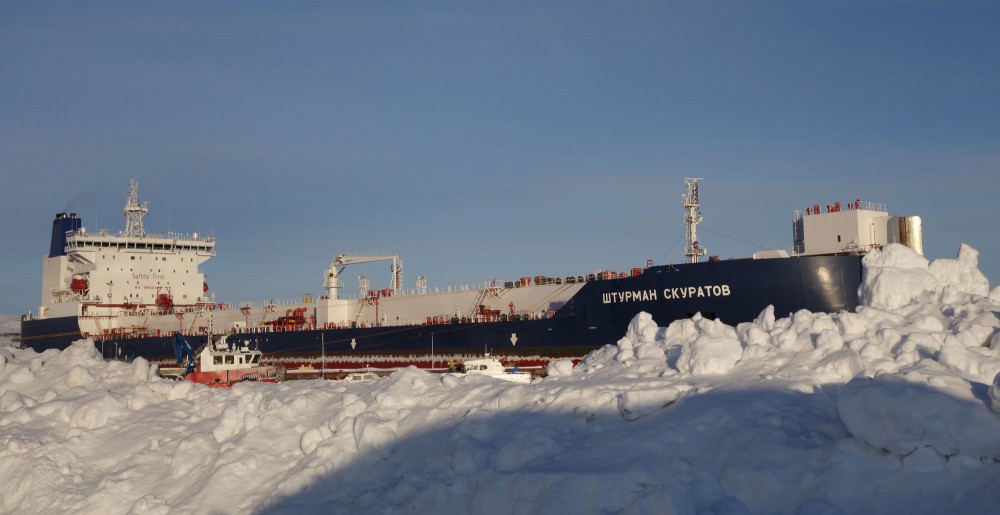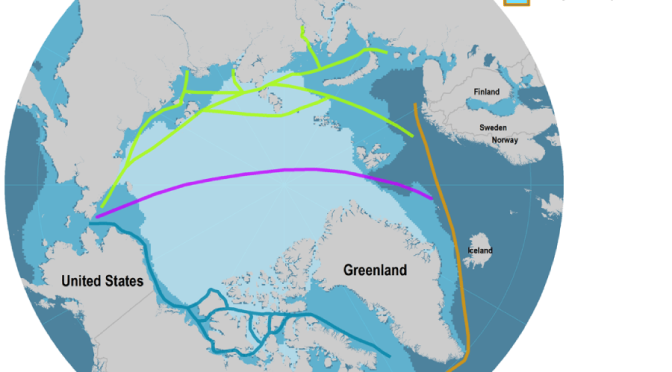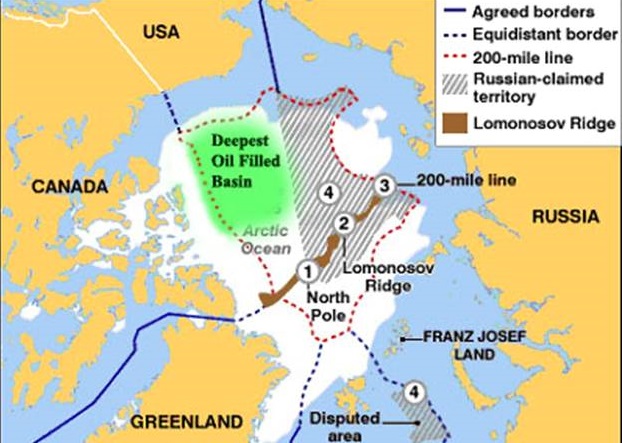The Arctic marine environment is changing profoundly in response to a warming planet. Historic physical changes to the Arctic’s sea ice cover are occurring rapidly, and these changes create greater marine access and potentially longer seasons of marine navigation. Are these changes, along with resulting increases in Arctic marine traffic, fomenting discord and conflict among the Arctic states and potentially between the Arctic states and global maritime enterprises? While some have speculated that such regional discord and conflict could lead to a new
Cold War or at least a hotbed of maritime tensions like those seen in the
South China Sea, a review of governance changes and international actions enhancing Arctic marine safety and environmental protection during the past two decades suggests an opposite conclusion. Indeed, as this blog explains, the Arctic’s current record is one of unprecedented international cooperation and dialogue on a suite of environmental security challenges associated with greater marine use.
A look at the activities of the
Arctic Council, an intergovernmental forum chartered in 1996 among the Arctic States (Canada, Denmark, Finland, Iceland, Norway, Russia, Sweden, and the United States), provides a glimpse into these states’ cooperative approach to protecting the Arctic’s people and marine environment. For example, focusing on environmental protection and sustainable development, the Council has used its Working Group on
Protection of the Arctic Marine Environment (PAME) to develop strategies and conduct assessments related to Arctic marine operations and shipping. PAME initiated a series of Arctic
marine strategic plans that provide a framework for its actions, including additional work on the impacts of Arctic climate change. In response to the council’s Arctic Climate Impact Assessment (ACIA) released in 2004, PAME initiated the
Arctic Marine Shipping Assessment (AMSA). Conducted from 2004 to 2009, the assessment provides three important elements: a
baseline assessment (a snapshot of Arctic marine use early in the 21st century); a
strategic guide for the Arctic states, Arctic residents, and an array of stakeholders; and a
policy framework of the Arctic Council and Arctic states. The 17 recommendations in the
AMSA 2009 Report focus on three interrelated themes: enhancing Arctic marine safety; protecting Arctic people and the environment; and building the Arctic marine infrastructure, which were negotiated by the Arctic state experts and approved by the Arctic Ministers in April 2009. These recommendations represent a solid framework that has been used to develop and implement many safety and protection measures across the Arctic during the past decade.
Two key AMSA recommendations regarding the need for agreements on practical issues have been acted on by the Arctic states using the Arctic Council process (which includes Arctic indigenous peoples and observer engagement) to negotiate key binding agreements for the Arctic Ocean. A
treaty on Arctic search and rescue (SAR) was signed by the Arctic Ministers in May 2011 during the Arctic Council Ministerial meeting in Nuuk, Greenland. A second
treaty on oil pollution preparedness and response was signed by the Arctic Ministers in May 2013 during the Arctic Council Ministerial meeting in Kiruna, Sweden. In addition, a new
treaty for the Central Arctic Ocean (CAO) was signed in October 2018 (by the five Arctic Ocean coastal states and Japan, China, South Korea, Iceland, and the EU) that bars unregulated fishing in the CAO for 16 years. The core of the treaty is the precautionary principle where the parties are taking strong action
before large scale fishing occurs; they have agreed to conduct scientific expeditions in the CAO to better understand this remote marine ecosystem undergoing great change.
Each of these Arctic state initiatives adds to the evolving governance complex of the Arctic Ocean through the development of enhanced safety and protection measures created under the legal framework provided by the
United Nations Convention on the Law of the Sea (UNCLOS). Notably, these initiatives also build upon the 2008
Ilulissat Declaration in which the five Arctic Ocean coastal states—Canada, Denmark (Greenland), Norway, Russia, and the United States—came together and stated that UNCLOS is the legal framework for the Arctic Ocean.
International organizations have also played a significant role in fostering cooperation on rules and regulations for polar ships and addressing the large gaps in Arctic marine infrastructure. For example, after more than two decades of study and negotiation, the
International Maritime Organization (IMO) approved a mandatory
IMO International Code for Ships Operating in Polar Waters (the Polar Code) that came fully into force in July 2018. The Polar Code amends three existing IMO instruments focusing on standards for safety, pollution prevention, and training, and includes the following elements: polar ship structural and equipment standards; marine safety and life-saving equipment; training and experience for polar mariners; a Polar Ship Certificate; a Polar Water Operations Manual (ship specific); and polar environmental rules.
IMO has also taken a more regional-based approach to governance in Arctic waters. After a joint submission by the Russian Federation and the United States,
IMO approved a voluntary ship routing scheme in Bering Strait in December 2018, one of the more environmentally sensitive regions of the global ocean. The scheme established six two-way routes (each four nautical miles wide) and six precautionary areas; the routes are voluntary for vessels 400 gross tonnage and above.
IMO is not the only international organization to support and promote cooperative regional action on issues of maritime affairs and to address many critical and limiting Arctic marine infrastructure issues. In October 2010, the
International Hydrographic Organization (IHO), an intergovernmental consultative body, established the
Arctic Regional Hydrographic Commission (ARHC) to address the availability of reliable navigation and environmental data in the Arctic Ocean. ARHC has explored the challenges of surveying and mapping the extensive uncharted waters of the Arctic marine environment and the feasible roles of public-private partnerships in this effort. In June 2011, the
World Meteorological Organization (WMO)—a specialized UN agency focusing on weather, climate, and hydrology—established (in concert with IMO and IHO) five new WMO Arctic meteorological areas (
METAREAS) covering Canada, Norway, and Russia and took responsibility for providing services in the new regions. The
International Ice Charting Working Group, a forum of the national ice centers, and the
International Association of Marine Aids to Navigation and Lighthouse Authorities have both enhanced their efforts across borders on sea ice mapping and forecasts, and Arctic navigation systems.
A new international organization, the
Arctic Coast Guard Forum (ACGF), was established in 2015 among the Coast Guards of the Arctic states and holds great promise for strengthening multilateral cooperation and coordination on marine operational issues. In September 2017, ACCGF held its first live SAR (search and rescue) exercises near Reykjavik, Iceland, and in April 2019, Finland hosted its second exercise in the northern Baltic Sea. Its strategic goals include creating a
common operational picture in the Arctic, advancing protection of the Arctic marine environment, and seeking
common solutions to Arctic maritime issues. The ACGF chair rotates every two years with the chair of the Arctic Council, ensuring a close connection with the Arctic ministers who steer the council’s cooperative initiatives and interests in marine affairs.
There are many international organizations, along with the Arctic states, that support and promote cooperative regional action on issues of maritime affairs and address many critical and limiting Arctic marine infrastructure issues. These international efforts have been focused on the practical aspects of Arctic marine safety and environmental protection and demonstrate a consistent pattern of close cooperation. Each effort has sought to further collaboration and constrain discord in the maritime world and within the Arctic community.
Rather than fuel a new Cold War in this century, Arctic states and the global maritime community have taken significant governance and policy measures that enhance regional stability and proactively address critical environmental security challenges in a cooperative manner. Future measures will evolve to address ship emissions, underwater sound, heavy fuel oil, ship routing, and other emerging marine challenges. Safe, secure, and effective uses of the Arctic Ocean are long-term goals for the region, and a foundation has been set to continue an era of exceptional cooperation among the Arctic and maritime states, the people who live in the Arctic, and the global shipping industry.
Dr. Lawson W. Brigham is a resident fellow at the Woodrow Wilson International Center for Scholars, a research professor at the University of Alaska Fairbanks, and a fellow at the U.S. Coast Guard Academy’s Center for Arctic Study & Policy.
Arctic climate change, climate change

www.law.upenn.edu











